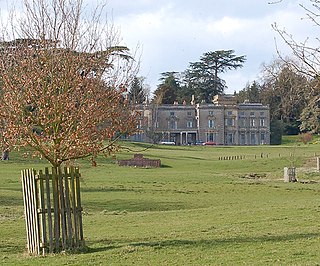
The Royal Observatory, Greenwich is an observatory situated on a hill in Greenwich Park in east London, overlooking the River Thames to the north. It played a major role in the history of astronomy and navigation, and because the Prime Meridian passes through it, it gave its name to Greenwich Mean Time, the precursor to today's Coordinated Universal Time. The ROG has the IAU observatory code of 000, the first in the list. ROG, the National Maritime Museum, the Queen's House and Cutty Sark are collectively designated Royal Museums Greenwich.

A theodolite is a precision optical instrument for measuring angles between designated visible points in the horizontal and vertical planes. The traditional use has been for land surveying, but they are also used extensively for building and infrastructure construction, and some specialized applications such as meteorology and rocket launching.
Sir James South FRS FRSE PRAS FLS LLD was a British astronomer.

Edward Troughton FRS FRSE FAS was a British instrument maker who was notable for making telescopes and other astronomical instruments.
William Simms was a British scientific instrument maker.

Thomas Cooke was a British scientific instrument maker based in York. He founded T. Cooke & Sons, the scientific instrument company.
T. Cooke & Sons was an English instrument-making firm, headquartered in York. It was founded by Thomas Cooke by 1837.
Cooke, Troughton & Simms was a British instrument-making firm formed in York in 1922 by the merger of T. Cooke & Sons and Troughton & Simms.

Jesse Ramsden FRS FRSE was a British mathematician, astronomical and scientific instrument maker. His reputation was built on the engraving and design of dividing engines which allowed high accuracy measurements of angles and lengths in instruments. He produced instruments for astronomy that were especially well known for maritime use where they were needed for the measurement of latitudes and for his surveying instruments which were widely used for cartography and land survey both across the British Empire and outside. An achromatic eyepiece that he invented for telescopes and microscopes continues to be known as the Ramsden eyepiece.

Armagh Observatory is an astronomical research institute in Armagh, Northern Ireland. Around 25 astronomers are based at the observatory, studying stellar astrophysics, the Sun, Solar System astronomy and Earth's climate.

The Ramsden surveying instruments are those constructed by Jesse Ramsden and used in high precision geodetic surveys carried out in the period 1784 to 1853. This includes the five great theodolites—great in name, great in size and great in accuracy—used in surveys of Britain and other parts of the world. Ramsden also provided the equipment used in the measurement of the many base lines of these surveys and also the zenith telescope used in latitude determinations.

The meridian circle is an instrument for timing of the passage of stars across the local meridian, an event known as a culmination, while at the same time measuring their angular distance from the nadir. These are special purpose telescopes mounted so as to allow pointing only in the meridian, the great circle through the north point of the horizon, the north celestial pole, the zenith, the south point of the horizon, the south celestial pole, and the nadir. Meridian telescopes rely on the rotation of the sky to bring objects into their field of view and are mounted on a fixed, horizontal, east–west axis.

Shuckburgh Hall is a privately owned country house mansion at Lower Shuckburgh, Warwickshire, near to Daventry in Northamptonshire.

The Shuckburgh telescope or Shuckburgh equatorial refracting telescope was a 4.1 inches (10.4 cm) diameter aperture telescope on an equatorial mount completed in 1791 for Sir George Shuckburgh (1751–1804) in Warwickshire, England, and built by British instrument maker Jesse Ramsden (1735–1800). It was transferred to the Royal Observatory, Greenwich in 1811 and the London Science Museum in 1929. Even though it has sometimes not been regarded as particularly successful, its design was influential. It was one of the larger achromatic doublet telescopes at the time, and one of the largest to have an equatorial mount. It was also known as the eastern equatorial for its location.
Jonathan Sisson was a prominent English instrument maker, the inventor of the modern theodolite with a sighting telescope for surveying, and a leading maker of astronomical instruments.

Jeremiah Sisson (1720-1783) was an English instrument maker who became one of the leaders of his profession in London. Jeremiah Sisson was the son of Jonathan Sisson, also a respected instrument maker, who trained him in the craft.

The Royal Observatory, Cape of Good Hope, is the oldest continuously existing scientific institution in South Africa. Founded by the British Board of Longitude in 1820, it now forms the headquarters building of the South African Astronomical Observatory.

The Giuseppe S. Vaiana Astronomical Observatory is an astronomical observatory located in Palermo, Sicily, Italy, housed inside the Palazzo dei Normanni. It is one of the research facilities of the National Institute of Astrophysics. The observatory carries out research projects in the field of astronomy and astrophysics including the study of solar and stellar coronas, stellar evolution and of the supernova remnants.
Anita McConnell (1936–2016) was a writer on the history of science and a curator of oceanography and geophysics at the Science Museum, London. She is most widely known for her popular Shire book on barometers but also wrote many books on the history of oceanography and British scientific instrument makers of the 18th and 19th centuries.


















